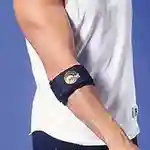Tennis Elbow Brace: How to use!
Tennis elbow is a painful ailment that develops when the tendons in your elbow are stretched by repetitive activities like playing tennis or painting. A brace supports your overused tendons, providing temporary relief from discomfort. You can alleviate your pain and resume your favorite activities by selecting a well-fitting brace and correctly applying it. Rest is required to heal your stressed tendons rather than simply a brace properly.
Use of Tennis Elbow braces
There are following steps to use this. Let’s start!
1.Lip the brace around your arm
Place your hand and forearm in the brace. Pull the brace up your forearm until the supporting strap reaches about 1 inch (2.5 cm) below your elbow. Rotate the forearm splint in the brace to put it on the thumb side of the arm.
2.The tendon cushion should be facing out when using the elbow brace
Move the brace so that the cushioned part that will support your tendon is on top of your forearm, facing outward. This often implies that the strap squeezing the tendon will be fastened to the underside of your forearm. This tendon cushion may be made of air or foam, depending on the brace.
3.Tighten the brace till it’s tight but not painful
Once the brace is in the right position, use the adjustable strap to tighten it. The brace should not limit your circulation when you grab a racket or create a fist. However, the brace should be snug enough so that it does not slide about on your arm.
4.Make any necessary modifications to ensure your comfort
Try the activity that gives you discomfort while wearing your brace. If it feels tight, loosen it. If you believe it isn’t providing adequate support, try tightening it. Adjust the brace till you experience the maximum relief.
5.Measure the circumference of your forearm one inch (2.5 cm) below
Choose the suitable brace size by taking this measurement with a tape measurer and comparing it to the size chart on the back of the brace packaging. Unisex sizes include small, medium, and large. Most braces have a foam layer that sits directly on the arm, as well as a woven strap that gives additional support to your stressed tendons.
Some braces also include a tiny gel pack, which may be frozen and used to reduce swelling. Most tennis elbow braces are designed to accommodate either arm. It is not essential to select a side-specific brace.
6.Select a brace with a strap measuring 1.97 in (5 cm) to 3.15 in (8 cm) broad.
Avoid employing a brace with a thinner support strap, since it may be insufficient to compress your swollen tendons. The size of this strap provides more support than the whole size of the brace.
Some braces are short, only slightly broader than the strap, while others are longer and span around both sides of the elbow. It is up to you to decide whatever style you like. Each brace normally has the same support strap and serves the same purpose.
7.Wear the brace whenever you need more support.
Wear your brace while doing your unpleasant activity or throughout the day if you need extra support. Wearing a brace will not harm you unless you put it on wrongly. If you are unsure about using a brace, get advice from a doctor, tennis professional, or physical therapist. They can all make you feel more secure about wearing your brace.
Read more about knee brace
Conclusion
A large range may be found at your local sports goods store. Purchase a brace from your local pharmacy or sports goods store. Your sports goods store may offer a wider range of braces and designs, as well as specialists who can fit you for a brace and explain to you how to use it correctly. If your tennis elbow developed after using a new racket, bring it to the retailer. You may ask a store employee whether it is the right weight and size for you to guarantee it is not aggravating your condition.
